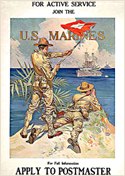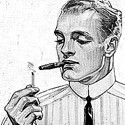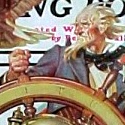J.C. Leyendecker
J.C. (Joe) Leyendecker appeared on the art scene at the end of the 1800s as an artistic rebel - tall, good looking and highly talented. Born in 1874 in Germany and emigrated with his parents and younger brother, Frank, to Chicago in 1882. Unable to pay for education, Leyendecker became an apprentice to J. Manz & Co., a Chicago engraving house at the age of 15.
In 1896 he learned of a poster contest and saw that as a way to help pay for more art education. He entered his art nouveau style painting and the panel of distinguished judges, including Maxfield Parrish, awarded him the first prize. The honor of a cover illustration for The Century magazine was just enough to launch his rise in the art field. He and his brother Frank were off to Paris and study at the Academie Julian. Here Joe was heavily influenced by such artists as Alphonse Mucha, Marcel Duchamp and Henri Matisse. But Joe developed his own style and flare which would land him the big jobs back in America.
Joe and Frank returned to Chicago in 1897 to set up a small art studio. Withing two years, Joe was regularly landing top projects and in 1899 moved to New York to work on commercial art for Proctor & Gamble. He was soon discovered by The Saturday Evening Post where over the next thirty years would become highly celebrated artist.
Leyendecker's Uncle Sam
In many ways Leyendecker's career paralleled Flagg's as both were thrust into two world wars as artists and illustrators. Flagg established the image of Uncle Sam, and Joe added broad, powerful brush strokes and then put him into a myriad of settings and scenes for countless magazine covers, articles and posters -- "U.S. at the Wheel" is just one excellent example.
A Visual Chronicle of America
Early in my art and design career I became infatuated with Leyendecker's style. A number of times I even attempted to emulate it -- which was impossible. I purchased the book J.C. Leyendecker by Michael Schau (1974, Watson-Guptill Publications, now out of print) and to this day delight in each page and each example of J.C.'s art. Over a career of fifty years J.C. produced literally hundreds of paintings - 322 Post covers between 1899 and 1943; plus, over 200 black and white illustrations.
The New Year's baby -- now an American icon -- first appeared on Leyendecker's New Year's Post cover for 1906. His Arrow Shirt character became a household image, and the heart-throb of every young woman. Schau writes:
"The impact of Leyendecker's Arrow Collar Man on the public's imagination was like that of a movie star. In one month in the early 1920s the Arrow Man received 17,000 fan letters, gifts, marriage proposals, and notes threatening suicide -- a deluge surpassing even Rudolph Valentino's mail at the star's apex."
Strength in Style
 His style was marked by wide, deliberate brush strokes and remarkable eye for detail and non-detail. He obviously worked very fast, carefully illustrating the important aspects of the subject while washing the unimportant with spontaneous splashes of color and texture. Since he had to generate lots of art very quickly, he would keep 'parts' of paintings handy as sketches, and many times incorporate those into more than one painting. He was known to draw heads of Arrow shirt models as recreational sketching, leaving the neck areas blank for adding in collars later.
His style was marked by wide, deliberate brush strokes and remarkable eye for detail and non-detail. He obviously worked very fast, carefully illustrating the important aspects of the subject while washing the unimportant with spontaneous splashes of color and texture. Since he had to generate lots of art very quickly, he would keep 'parts' of paintings handy as sketches, and many times incorporate those into more than one painting. He was known to draw heads of Arrow shirt models as recreational sketching, leaving the neck areas blank for adding in collars later.
 The most wonderful part of his art were the images of people, their expressions and posture. He didn't just paint people. His subjects were always dramatic, and posed in active/interactive positions, many times under great stress. His women were beautiful, his men were handsome and the incorporation of children, angels, animals and all kinds of floral embellishments made each painting a fascinating vision.
The most wonderful part of his art were the images of people, their expressions and posture. He didn't just paint people. His subjects were always dramatic, and posed in active/interactive positions, many times under great stress. His women were beautiful, his men were handsome and the incorporation of children, angels, animals and all kinds of floral embellishments made each painting a fascinating vision.
In this painting for the Marines (between 1914 and 1918) he moved from highly detailed, yet stylized, clothing, to the broad suggestions of ships at sea. (See this detail.) We feel as if we are part of the scene the day it happened, even though most of the pictorial details are omitted.
Realism mixed with Fantasy
While his renderings suggested real people with realistic dress and props, J.C. always had a superb eye for using historic and even fantasy elements in each painting. In his "War Bonds" painting, the embellishments on the shield and sword lend an actual touch-and-feel quality to the image. Just look at what the eagle does for us in "Uncle Sam at the Wheel" -- a monumental statement. Notice the part played by the doves in his 1935 "4th of July" cover -- they reinforce the brass sound of the ringing bell. Notice the knuckles on the bell-ringer's hand! He is unaware of the stress because of his part in the scene. And on and on.
In 50 years of Leyendecker's prolific career, he defined American life, joy, desperation and hopes in a cavalcade of wonderful illustrations, posters, advertisements, and magazine covers. His art breathed life into many of today's well known brands... Kellogs, Ivory Soap, and a few now gone... Chesterfield Cigarettes, Pierce Arrow Automobiles and; posters for magazines as well as recruitment posters from both world wars; and book and magazine illustrations. And on and on.
If you can get your hands on a copy of Schau's book -- do it. If you can buy it, buy it now. And the next time you are challenged with the task of creating a patriotic image -- for whatever purpose or client -- dig into the works of J.C. Leyendecker and James Montgomery Flagg. Because it's there you'll find the very spirit of what it takes to fully visualize the epitome of patriotism.
Until next time...
Thanks for reading
![]()
This look at Patriotic Art & Design, and tributes to Leyendecker and Flagg utilized images and references from many, many sources including:
Bibliography
Book References:
- James Montgomery Flagg by Susan E. Aieyer 207 pages, Publisher: Watson-Guptill Publications; (1974)
- J.C. Leyendecker by Michael Schau; 1974, Watson-Guptill Publications, now out of print
- A Century of Posters by Martijn F. Le Coultre, Alston W. Purvis; Paperback: 448 pages; Publisher: Lund Humphries Publishers; (September 1, 2002)
- History of the Poster by Josef Muller-Brockmann, Shizuko Muller-Brockmann; Paperback: 244 pages, Publisher: Phaidon Press; (May 1, 2004)
- Design for Victory: World War II Posters on the American Home Front by William Bird, Harry R. Rubenstein, William L. Bird; Paperback: 111 pages, Publisher: Princeton Architectural Press; (June 1, 1998)
- The J. C. Leyendecker Collection: American Illustrators Poster Book by Steine; Paperback, Publisher: Ten Speed Press; (November 1, 1995)
- Posters a Concise History by John Barnicoat, Paperback: 288 pages ; Dimensions (in inches): 0.64 x 8.28 x 5.92, Publisher: Thames & Hudson; Rep edition (February 1, 1985)
Web Site References:
- Bud Plant's wonderful Illustrated Book site helped out with a number of items. This is a wonderful place to learn about a wide array of famous people, including artists like J.C. Leyendecker and James Montgomery Flagg. That's www.bpib.com
- Jules Abel Faivre's "On les aura!" poster and U.S. Bonds Boy Scout Poster, both from Washington University faculty Stephen T Kerr
- J.C. Leyendecker's "For Active Duty" poster for the U.S. Marines is from the University of North Carolina archives at UNC.edu
- J.C. Leyendecker covers were all found in the University of Virginia's pictorial archives
- Your Chums Are Fighting, Why Aren't You? is from the National Archives of Canada, Artist: C.J. Patterson
- World War I Navy Recruitment Poster "Gee, I wish I were a man", Howard Chandler Christy is from the Columbia University Maritime Gallery
- James Montgomery Flagg Illustrator is from America's Library at www.americaslibrary.gov
- Uncle Sam at the Wheel, is from the "Antique Shop" www.the-antique-shop.com
- The Declaration of Independence by Ann Miller is from AllPosters.com
- The fine art print "Vision Print" by artist Lois Babb is from "Great Americana.com"
- Enduring Freedom drawing montage poster is from american-patriotic-history-poster.us
- Some of the clip art images came from the Ace Clip Art Site
- Collection of low-res Flags, Bunting and Banners are found at the Flag art site
- The story of Nancy Wake THE WHITE MOUSE decorated servicewoman of WWII; "Your Talk May Kill Your Comrades", 1942 Poster for the war office by Abram Games -- www.nzedge.com
Return to the Design Department, or back to the Front Page
Participate in your Design Center
Lots of fun and information for all... don't forget, any community is only as good as the participation of its members. We invite your tips, tricks, comments, suggestions and camaraderie.- Ask for the DT&G Monthly: to receive news about DT& headlines, happenings in the Design Center and regular columns like the "Mail Bag" and "Cool Sites"
- SUBSCRIBE : to the Designers' CAFE email list


